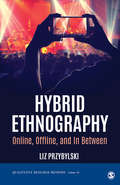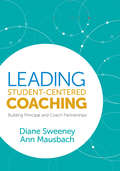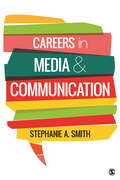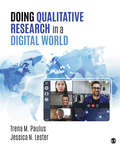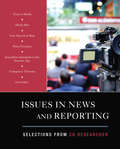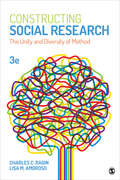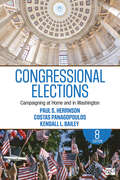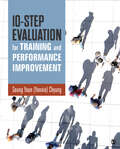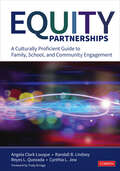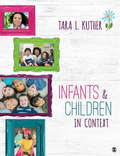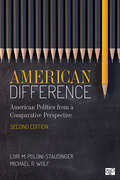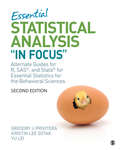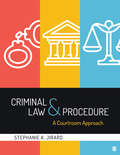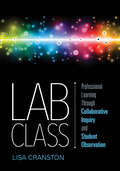- Table View
- List View
Hybrid Ethnography: Online, Offline, and In Between (Qualitative Research Methods #58)
by Liz PrzybylskiToday′s research landscape requires an updated set of analytical skills to tell the story of how people interact with and make meaning from contemporary culture. Hybrid Ethnography: Online, Offline, and In Between provides researchers with concrete and theory-based processes to combine online and offline research methods to tell the story of how and why people are interacting with expressive culture. This book provides a roadmap for combining online and in-person ethnographic research in an explicit manner to support the reality of much contemporary fieldwork. In the tradition of the Qualitative Research Methods series, this concise book serves graduate students and faculty learning ethnography and field methods, as well as those designing, conducting, and writing up their own dissertations and research studies. From choosing the pursue a hybrid ethnographic strategy to collecting data to analyzing and sharing results, author Liz Przybylski covers all aspects of conducting a hybrid ethnography study. Hybrid Ethnography was awarded Honorable Mention for the 2021 Bruno Nettle Prize given by the Society for Ethnomusicology!
Hybrid Ethnography: Online, Offline, and In Between (Qualitative Research Methods #58)
by Liz PrzybylskiToday′s research landscape requires an updated set of analytical skills to tell the story of how people interact with and make meaning from contemporary culture. Hybrid Ethnography: Online, Offline, and In Between provides researchers with concrete and theory-based processes to combine online and offline research methods to tell the story of how and why people are interacting with expressive culture. This book provides a roadmap for combining online and in-person ethnographic research in an explicit manner to support the reality of much contemporary fieldwork. In the tradition of the Qualitative Research Methods series, this concise book serves graduate students and faculty learning ethnography and field methods, as well as those designing, conducting, and writing up their own dissertations and research studies. From choosing the pursue a hybrid ethnographic strategy to collecting data to analyzing and sharing results, author Liz Przybylski covers all aspects of conducting a hybrid ethnography study. Hybrid Ethnography was awarded Honorable Mention for the 2021 Bruno Nettle Prize given by the Society for Ethnomusicology!
Leading Student-Centered Coaching: Building Principal and Coach Partnerships
by Diane Sweeney Ann MausbachEssential leadership moves for supporting instructional coaching in your school Strong leadership is essential in any successful instructional coaching effort. Leading Student-Centered Coaching provides principals and district leaders with the background, practices, and tools required for leading coaching efforts that have a profound and positive impact on student and teacher learning. Filled with practical ideas that school leaders can easily apply to their own school settings, this book includes: Tools and techniques for preparing a school for coaching, launching a coaching culture, and supporting coaches Leadership Moves sections that provide strategies for building principal and coach partnerships Richly detailed Lessons from the Field, based on the authors’ real-life experiences, that illustrate principal and coach collaboration Recommendations for coaches to use as they strive to increase their impact With a focus on the critical role of school leadership, this action-oriented guide provides the key ingredients for ensuring the success of school-based coaching initiatives. "Sweeney and Mausbach explore the necessary ingredients to a successful instructional coach partnership between the principal and the coaches. This is a must-read for building leadership teams implementing an instructional coach program" —Timothy S. Grieves, Chief Administrator Northwest Area Education Agency, IA "This book synthesized the work necessary of school leaders when working with the coach. As a principal who was a student-centered coach, this book has shown me how I can tweak the skills I learned and apply them with a leadership lens." —Kelly Neylon, Principal Meadowview School, Woodridge IL
Leading Student-Centered Coaching: Building Principal and Coach Partnerships
by Diane Sweeney Ann MausbachEssential leadership moves for supporting instructional coaching in your school Strong leadership is essential in any successful instructional coaching effort. Leading Student-Centered Coaching provides principals and district leaders with the background, practices, and tools required for leading coaching efforts that have a profound and positive impact on student and teacher learning. Filled with practical ideas that school leaders can easily apply to their own school settings, this book includes: Tools and techniques for preparing a school for coaching, launching a coaching culture, and supporting coaches Leadership Moves sections that provide strategies for building principal and coach partnerships Richly detailed Lessons from the Field, based on the authors’ real-life experiences, that illustrate principal and coach collaboration Recommendations for coaches to use as they strive to increase their impact With a focus on the critical role of school leadership, this action-oriented guide provides the key ingredients for ensuring the success of school-based coaching initiatives. "Sweeney and Mausbach explore the necessary ingredients to a successful instructional coach partnership between the principal and the coaches. This is a must-read for building leadership teams implementing an instructional coach program" —Timothy S. Grieves, Chief Administrator Northwest Area Education Agency, IA "This book synthesized the work necessary of school leaders when working with the coach. As a principal who was a student-centered coach, this book has shown me how I can tweak the skills I learned and apply them with a leadership lens." —Kelly Neylon, Principal Meadowview School, Woodridge IL
Careers in Media and Communication
by Stephanie A. SmithCareers in Media and Communication is a practical resource that helps students understand how a communication degree prepares them for a range of fulfilling careers; it gives students the skills they will need to compete in a changing job market. Award-winning teacher and author Stephanie A. Smith draws from her years of professional experience to guide students through the trends and processes of identifying, finding, and securing a job in in mass communication. Throughout the book, students explore the daily lives of professionals currently working in the field, as well as gain firsthand insights into the training and experience that hiring managers seek.
Careers in Media and Communication
by Stephanie A. SmithCareers in Media and Communication is a practical resource that helps students understand how a communication degree prepares them for a range of fulfilling careers; it gives students the skills they will need to compete in a changing job market. Award-winning teacher and author Stephanie A. Smith draws from her years of professional experience to guide students through the trends and processes of identifying, finding, and securing a job in in mass communication. Throughout the book, students explore the daily lives of professionals currently working in the field, as well as gain firsthand insights into the training and experience that hiring managers seek.
Doing Qualitative Research in a Digital World
by Jessica Nina Lester Trena M. PaulusWhile some qualitative methods texts touch upon online communities as a potential data source, show how to conduct interviews and focus groups online, or select recording devices and analysis software, no book to date has guided readers in the creation of a comprehensive digital workflow for their research. By working through each chapter in this book, readers will be able to generate a unique digital workflow for designing and implementing their research. The book provides a deep exploration of the relationship between theories of technology, substantive theories, and methodological theory, and shows how together these inform the development of a quality research design. The authors include vignettes—narratives written by qualitative researchers describing cutting-edge use of digital tools and spaces—and also give examples of published studies, which together provide practical illustration of the content. Woven throughout is explicit attention to ethical challenges that are likely to be faced by researchers when adopting digital tools. The book invites readers to engage in a critical appraisal of the role of technology in qualitative research through reflection, conversation, and engagement with the larger community of researchers.
Doing Qualitative Research in a Digital World
by Jessica Nina Lester Trena M. PaulusWhile some qualitative methods texts touch upon online communities as a potential data source, show how to conduct interviews and focus groups online, or select recording devices and analysis software, no book to date has guided readers in the creation of a comprehensive digital workflow for their research. By working through each chapter in this book, readers will be able to generate a unique digital workflow for designing and implementing their research. The book provides a deep exploration of the relationship between theories of technology, substantive theories, and methodological theory, and shows how together these inform the development of a quality research design. The authors include vignettes—narratives written by qualitative researchers describing cutting-edge use of digital tools and spaces—and also give examples of published studies, which together provide practical illustration of the content. Woven throughout is explicit attention to ethical challenges that are likely to be faced by researchers when adopting digital tools. The book invites readers to engage in a critical appraisal of the role of technology in qualitative research through reflection, conversation, and engagement with the larger community of researchers.
Issues in News and Reporting: Selections from CQ Researcher
by CQ ResearcherCan News Outlets Regain the Public’s Confidence? Can Governments Control the Press in the Internet Age? Should Americans Have a Right "To Be Forgotten"? Written by award-winning CQ Researcher journalists, this collection of non-partisan reports focuses on 12 hot-button issues facing journalists and news organizations. With reports ranging from perceptions of media bias and threats to free speech, Issues in News and Reporting promotes in-depth discussion, facilitates further research, and helps readers formulate their own positions on crucial issues. And because it’s CQ Researcher, the reports are expertly researched and written, presenting readers with all sides of an issue. Key Features: Chapters follow a consistent organization, beginning with a summary of the issue, then exploring a number of key questions around the issue, next offering background to put the issue into current context, and concluding with a look ahead. A pro/con debate box in every chapter offer readers the opportunity to critically analyze and discuss the issues by exploring a debate between two experts in the field. All issues include a chronology, a bibliography, photos, charts, and figures to offer readers a more complete picture of the issue at hand.
Issues in News and Reporting: Selections from CQ Researcher
by CQ ResearcherCan News Outlets Regain the Public’s Confidence? Can Governments Control the Press in the Internet Age? Should Americans Have a Right "To Be Forgotten"? Written by award-winning CQ Researcher journalists, this collection of non-partisan reports focuses on 12 hot-button issues facing journalists and news organizations. With reports ranging from perceptions of media bias and threats to free speech, Issues in News and Reporting promotes in-depth discussion, facilitates further research, and helps readers formulate their own positions on crucial issues. And because it’s CQ Researcher, the reports are expertly researched and written, presenting readers with all sides of an issue. Key Features: Chapters follow a consistent organization, beginning with a summary of the issue, then exploring a number of key questions around the issue, next offering background to put the issue into current context, and concluding with a look ahead. A pro/con debate box in every chapter offer readers the opportunity to critically analyze and discuss the issues by exploring a debate between two experts in the field. All issues include a chronology, a bibliography, photos, charts, and figures to offer readers a more complete picture of the issue at hand.
Constructing Social Research: The Unity and Diversity of Method (Sociology For A New Century Ser.)
by Charles C. Ragin Lisa M. AmorosoThe updated Third Edition of this innovative text shows the unity within the diversity of activities called social research to help students understand how all social researchers construct representations of social life using theories, systematic data collection, and careful examination of that data. The book tackles questions like "What is social research?", "How does it differ from journalism, documentary film-making, or laboratory research in the natural sciences?", and "What is the researcher′s obligation to those he or she is studying?" Updated throughout with new references and examples, this edition is designed to evoke challenging questions regarding the nature of representation and the ethical challenges facing social scientific researchers. The text moves beyond standard research challenges to push readers to see the complex relationships among ethics, ideas, evidence, and outcomes.
Constructing Social Research: The Unity and Diversity of Method (Sociology For A New Century Ser.)
by Charles C. Ragin Lisa M. AmorosoThe updated Third Edition of this innovative text shows the unity within the diversity of activities called social research to help students understand how all social researchers construct representations of social life using theories, systematic data collection, and careful examination of that data. The book tackles questions like "What is social research?", "How does it differ from journalism, documentary film-making, or laboratory research in the natural sciences?", and "What is the researcher′s obligation to those he or she is studying?" Updated throughout with new references and examples, this edition is designed to evoke challenging questions regarding the nature of representation and the ethical challenges facing social scientific researchers. The text moves beyond standard research challenges to push readers to see the complex relationships among ethics, ideas, evidence, and outcomes.
Congressional Elections: Campaigning at Home and in Washington (Power, Conflict And Democracy Ser.)
by Costas Panagopoulos Paul S. Herrnson Kendall L. Bailey"It is the gold standard for texts on congressional campaigns and elections." — Bruce A. Larson, Gettysburg College In Congressional Elections: Campaigning at Home and in Washington authors Paul Herrnson and Costas Panagopoulos combine top-notch research with real-world politics as they argues that successful candidates run two campaigns: one for votes, the other for resources. Using campaign finance data, original survey research, and hundreds of interviews with candidates and political insiders, Herrnson and Panagopoulos look at how this dual strategy affects who wins and how it ultimately shapes the entire electoral system. The Eighth Edition considers the impact of the Internet and social media on campaigning in the 2018 elections; the growing influence of interest groups; and the influence of new voting methods on candidate, party, and voter mobilization tactics.
10-Step Evaluation for Training and Performance Improvement
by Seung Youn ChyungWritten with a learning-by-doing approach in mind, 10-Step Evaluation for Training and Performance Improvement gives students actionable instruction for identifying, planning, and implementing a client-based program evaluation. The book introduces readers to multiple evaluation frameworks and uses problem-based learning to guide them through a 10-step evaluation process. As students read the chapters, they produce specific deliverables that culminate in a completed evaluation project.
10-Step Evaluation for Training and Performance Improvement
by Seung Youn ChyungWritten with a learning-by-doing approach in mind, 10-Step Evaluation for Training and Performance Improvement gives students actionable instruction for identifying, planning, and implementing a client-based program evaluation. The book introduces readers to multiple evaluation frameworks and uses problem-based learning to guide them through a 10-step evaluation process. As students read the chapters, they produce specific deliverables that culminate in a completed evaluation project.
Equity Partnerships: A Culturally Proficient Guide to Family, School, and Community Engagement
by Randall B. Lindsey Reyes L. Quezada Cynthia L. Jew Angela R. Clark-LouqueHow often do you hear, "The only parents who showed were the parents who didn’t need to be here." But how often do you consider time of day, lack of child care, cost of dinner, transportation, language of the presentation, even relevance of the topic—all real-world barriers for families of our historically underserved students. Here at last is a resource that will open up access and reveal all-new ways to forge more culturally inclusive partnerships with families and communities . . . partnerships that extend well beyond parent-teacher conferences, PTA meetings, and the occasional bake sale. The two big services Equity Partnerships provides? Using the Tools of Cultural Proficiency, you’ll Discover new concepts and strategies to engage families and communities—and reduce, if not eliminate, barriers--through four essential principles: communication, connection, collaboration, and community Engage in frequent opportunities to reflect on your own assumptions and values, then collaborate with colleagues to co-create systemic practices and policies for devising, implementing, and assessing family and community engagement actions in your schools and districts We know inherently that family and community engagement is critical to the success of our students. Let Equity Partnerships be your go-to tool for breaking down the walls that for too long have limited all of us. "Raising the next generation is a shared responsibility and privilege. These authors have been first responders for decades by promoting Cultural Proficiency as a means to ensure equity and access for all. In Equity Partnerships, they identify the powerful and critical link of family, school, and community engagement to strengthen families, build community support, and increase student success." --TRUDY ARRIAGA, Associate Dean for Equity and Outreach, California Lutheran University, and Coauthor of Opening Doors
Equity Partnerships: A Culturally Proficient Guide to Family, School, and Community Engagement
by Randall B. Lindsey Reyes L. Quezada Cynthia L. Jew Angela R. Clark-LouqueHow often do you hear, "The only parents who showed were the parents who didn’t need to be here." But how often do you consider time of day, lack of child care, cost of dinner, transportation, language of the presentation, even relevance of the topic—all real-world barriers for families of our historically underserved students. Here at last is a resource that will open up access and reveal all-new ways to forge more culturally inclusive partnerships with families and communities . . . partnerships that extend well beyond parent-teacher conferences, PTA meetings, and the occasional bake sale. The two big services Equity Partnerships provides? Using the Tools of Cultural Proficiency, you’ll Discover new concepts and strategies to engage families and communities—and reduce, if not eliminate, barriers--through four essential principles: communication, connection, collaboration, and community Engage in frequent opportunities to reflect on your own assumptions and values, then collaborate with colleagues to co-create systemic practices and policies for devising, implementing, and assessing family and community engagement actions in your schools and districts We know inherently that family and community engagement is critical to the success of our students. Let Equity Partnerships be your go-to tool for breaking down the walls that for too long have limited all of us. "Raising the next generation is a shared responsibility and privilege. These authors have been first responders for decades by promoting Cultural Proficiency as a means to ensure equity and access for all. In Equity Partnerships, they identify the powerful and critical link of family, school, and community engagement to strengthen families, build community support, and increase student success." --TRUDY ARRIAGA, Associate Dean for Equity and Outreach, California Lutheran University, and Coauthor of Opening Doors
Infants and Children in Context
by Tara L. KutherLike children themselves, development is dynamic. In the chronologically organized Infants and Children in Context, award-winning author Tara L. Kuther frames development research in real-life contexts, including gender, race and ethnicity, socioeconomic status, and more. Kuther presents highly relatable examples, vivid cross-cultural stories, and case studies of real individuals, consistently prompting students to reflect on chapter content with What do you think? critical thinking questions. The book emphasizes three core themes: the centrality of context, the importance of research, and the applied value of developmental science; students will come away with an understanding of these themes that they will immediately be able to apply to their own lives and future careers. INSTRUCTORS: Infants and Children in Context is accompanied by a complete teaching and learning package! SAGE Vantage Digital Option SAGE Vantage is an intuitive digital platform that delivers this text’s content in a learning experience carefully designed to ignite student engagement and drive critical thinking. Built with you and your students in mind, it offers easy course set-up and enables students to better prepare for class. Assignable Video Assignable Video (available on the SAGE Vantage platform) is tied to learning objectives and curated exclusively for this text to bring concepts to life and appeal to different learning styles. LMS Cartridge (formally known as SAGE Coursepacks) Import this title’s instructor resources into your school’s learning management system (LMS) and save time. Don’t use an LMS? You can still access all of the same online resources for this title via the password-protected Instructor Resource Site. Looking for more coverage for your child and adolescence course? Kuther’s Child and Adolescent Development in Context covers development from infancy through adolescence.
Infants and Children in Context
by Tara L. KutherLike children themselves, development is dynamic. In the chronologically organized Infants and Children in Context, award-winning author Tara L. Kuther frames development research in real-life contexts, including gender, race and ethnicity, socioeconomic status, and more. Kuther presents highly relatable examples, vivid cross-cultural stories, and case studies of real individuals, consistently prompting students to reflect on chapter content with What do you think? critical thinking questions. The book emphasizes three core themes: the centrality of context, the importance of research, and the applied value of developmental science; students will come away with an understanding of these themes that they will immediately be able to apply to their own lives and future careers. INSTRUCTORS: Infants and Children in Context is accompanied by a complete teaching and learning package! SAGE Vantage Digital Option SAGE Vantage is an intuitive digital platform that delivers this text’s content in a learning experience carefully designed to ignite student engagement and drive critical thinking. Built with you and your students in mind, it offers easy course set-up and enables students to better prepare for class. Assignable Video Assignable Video (available on the SAGE Vantage platform) is tied to learning objectives and curated exclusively for this text to bring concepts to life and appeal to different learning styles. LMS Cartridge (formally known as SAGE Coursepacks) Import this title’s instructor resources into your school’s learning management system (LMS) and save time. Don’t use an LMS? You can still access all of the same online resources for this title via the password-protected Instructor Resource Site. Looking for more coverage for your child and adolescence course? Kuther’s Child and Adolescent Development in Context covers development from infancy through adolescence.
American Difference: A Guide to American Politics in Comparative Perspective
by Michael R. Wolf Lori M. Poloni-StaudingerExamining democracies from a comparative perspective helps us better understand why politics—or, as Harold Lasswell famously said, "who gets what, when, and how"—differ among democracies. American Difference: A Guide to American Politics in Comparative Perspective takes the reader through different aspects of democracy—political culture, institutions, interest groups, political parties, and elections—and, unlike other works, explores how the United States is both different from and similar to other democracies. The fully updated Second Edition has been expanded to include several new chapters and discussion on civil liberties and civil rights, constitutional arrangements, elections and electoral institutions, and electoral behavior. This edition also includes data around the 2016 general election and 2018 midterm election.
Essential Statistical Analysis "In Focus": Alternate Guides for R, SAS, and Stata for Essential Statistics for the Behavioral Sciences
by Yu Lei Kristin L. Sotak Gregory J. PriviteraEssentials of Statistical Analysis "In Focus" supports users of Gregory J. Privitera’s Essential Statistics for the Behavioral Sciences, Second Edition who work with a statistical program other than SPSS® or Excel®. Three standalone parts, each dedicated to R, SAS®, and Stata®, serve as step-by-step guides for completing the "In Focus" exercises in Privitera’s core text. A conversational writing style along with "To The Student" introductions allow students to familiarize themselves and become more comfortable with each program prior to making computations. Additionally, General Instruction Guidebook (GIG) sections for R, SAS®, and Stata® provide standardized how-to instructions for using each program, making the book a valuable reference for students beyond their studies.
Essential Statistical Analysis "In Focus": Alternate Guides for R, SAS, and Stata for Essential Statistics for the Behavioral Sciences
by Yu Lei Kristin L. Sotak Gregory J. PriviteraEssentials of Statistical Analysis "In Focus" supports users of Gregory J. Privitera’s Essential Statistics for the Behavioral Sciences, Second Edition who work with a statistical program other than SPSS® or Excel®. Three standalone parts, each dedicated to R, SAS®, and Stata®, serve as step-by-step guides for completing the "In Focus" exercises in Privitera’s core text. A conversational writing style along with "To The Student" introductions allow students to familiarize themselves and become more comfortable with each program prior to making computations. Additionally, General Instruction Guidebook (GIG) sections for R, SAS®, and Stata® provide standardized how-to instructions for using each program, making the book a valuable reference for students beyond their studies.
Criminal Law and Procedure: A Courtroom Approach
by Stephanie A. JirardWritten by a former federal prosecutor and public defender, Criminal Law and Procedure: A Courtroom Approach introduces students to the essentials of criminal law and procedure by illuminating the legal issues justice professionals face before, during, and after a criminal trial. Through the examination of statutes, edited case excerpts, and recent constitutional interpretation of black letter law, the text bridges the gap between learning criminal procedure and applying criminal law. Drawing from author Stephanie A. Jirard’s vast experience in both the courtroom and the classroom, Criminal Law and Procedure gets students to think critically about real-world issues and practice applying the law in a just and meaningful way. Accessible and engaging, this text presents criminal law and procedure as an exciting opportunity to have a direct, positive impact on our communities and the criminal justice system. Key Features: "Making the Courtroom Connection" boxes help students apply the legal concepts they learn to real-life issues facing law enforcement, the court system, and correctional institutions today. Edited case excerpts connect criminal law and procedure with current case material on relevant topics so students can see the impact of judicial decision making. "Applying the Law to the Facts" boxes engage students’ critical thinking skills and enhance their logical problem-solving abilities by providing opportunities to apply the rule of law to different scenarios. "Springboard for Discussion" prompts spark conversations and invite students to contrast the moral, ethical, and legal implications of criminal law and procedure in a larger context. Problem-solving exercises at the end of each chapter provide students with opportunities to test themselves on the material before a formal assessment. Active Learning Exercises in the Instructor’s Manual enable professors to offer additional opportunities for experiential learning. Give your students the SAGE edge! SAGE edge offers a robust online environment featuring an impressive array of free tools and resources for review, study, and further exploration, keeping both instructors and students on the cutting edge of teaching and learning.
Lab Class: Professional Learning Through Collaborative Inquiry and Student Observation
by Lisa Ann CranstonSchool-based, collaborative teacher learning that drives student achievement Meaningful growth in teacher practice comes when we invest in teacher-led, inquiry-based collaborative models where teachers get to roll up their sleeves and study what’s really going on in classrooms. Lab Class introduces an observation-based professional learning design that helps teachers collaboratively plan, investigate, and develop solutions to a specific problem of practice by observing a host teacher’s classroom through the eyes of students. This book provides instructional leaders and team facilitators with observation protocols that encourage teachers to: Plan collaborative inquiry projects by identifying a focus of the inquiry, combing the research literature, creating norms for observations, and identifying resources needed Observe and analyze student conversations, actions, and products to determine the impact of instructional decisions on students Identify patterns from observations and determine next steps for professional learning Close the knowing-doing gap by bringing professional learning out of workshops and back where it belongs—in the classroom! "For those looking to empower teachers by bringing the learning of teaching closer to the classroom, this resource will help you achieve your goals." —Jenni Donohoo, Provincial Literacy Lead, Council of Ontario Directors of Education Author of Collective Efficacy "Lab Class is a professional learning structure to take learning walks to the next level. It provides a process to deepen inquiry and focus teacher observations and learning." —Ellen S. Perconti, Superintendent Mary M. Knight School District, WA
Lab Class: Professional Learning Through Collaborative Inquiry and Student Observation
by Lisa Ann CranstonSchool-based, collaborative teacher learning that drives student achievement Meaningful growth in teacher practice comes when we invest in teacher-led, inquiry-based collaborative models where teachers get to roll up their sleeves and study what’s really going on in classrooms. Lab Class introduces an observation-based professional learning design that helps teachers collaboratively plan, investigate, and develop solutions to a specific problem of practice by observing a host teacher’s classroom through the eyes of students. This book provides instructional leaders and team facilitators with observation protocols that encourage teachers to: Plan collaborative inquiry projects by identifying a focus of the inquiry, combing the research literature, creating norms for observations, and identifying resources needed Observe and analyze student conversations, actions, and products to determine the impact of instructional decisions on students Identify patterns from observations and determine next steps for professional learning Close the knowing-doing gap by bringing professional learning out of workshops and back where it belongs—in the classroom! "For those looking to empower teachers by bringing the learning of teaching closer to the classroom, this resource will help you achieve your goals." —Jenni Donohoo, Provincial Literacy Lead, Council of Ontario Directors of Education Author of Collective Efficacy "Lab Class is a professional learning structure to take learning walks to the next level. It provides a process to deepen inquiry and focus teacher observations and learning." —Ellen S. Perconti, Superintendent Mary M. Knight School District, WA
